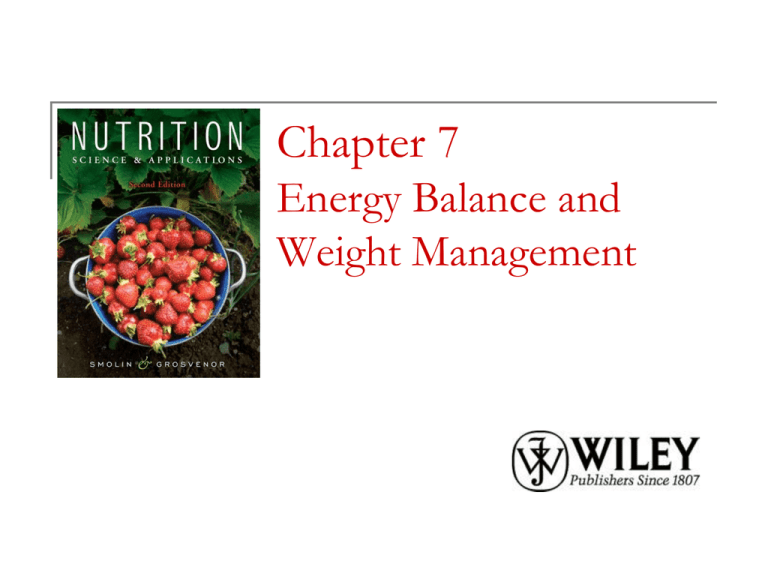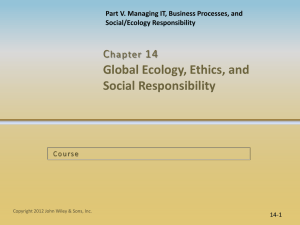
Chapter 7
Energy Balance and
Weight Management
America’s Expanding Waistline
Copyright 2010, John Wiley & Sons, Inc.
Weight Management Terms
Overweight is being too heavy for one’s height or
having a BMI of 25–29.
Obesity is characterized by excess body fat or a BMI
over 30.
Copyright 2010, John Wiley & Sons, Inc.
BMI
(Body
Mass
Index)
Calculate
BMI, where
do you fall?
Copyright 2010, John Wiley & Sons, Inc.
BMI and Disease Risk
Copyright 2010, John Wiley & Sons, Inc.
Determining Who Should Lose Weight
Evaluate high BMIs. (Is higher BMI due to
muscle mass or fat?)
Assess medical risk factors.
Copyright 2010, John Wiley & Sons, Inc.
Which statement about obesity is true?
Obesity rates have remained constant
over the last 15 years
Obesity is defined as having a BMI
over 25
Obesity rates are constant across
racial and ethnic groups
Obesity is defined as having a BMI
over 30
Copyright 2010, John Wiley & Sons, Inc.
Energy Balance
Energy balance occurs when energy
consumed equals energy expenditure.
Energy is measured in kilocalories (kcal,
kcalories) or kilojoules (kjoules, kJ).
Copyright 2010, John Wiley & Sons, Inc.
As food molecules are
broken down, the energy
in the chemical bonds of
carbohydrates, proteins
and fats are converted to:
a)
electrical energy
b)
c)
d)
carbon dioxide
ATP
electrons
Copyright 2010, John Wiley & Sons, Inc.
Body Energy
When weight loss occurs, body energy
stores are used.
When weight gain occurs, body energy
stores are built.
Copyright 2010, John Wiley & Sons, Inc.
Estimating the Energy Content of Food
Copyright 2010, John Wiley & Sons, Inc.
Stored Energy in the Body
Copyright 2010, John Wiley & Sons, Inc.
Primarily, energy is stored in
the body as ___________ and
____________.
glycogen,
triglycerides
glucose,
triglycerides
muscle, glycogen
protein, glucose
Copyright 2010, John Wiley & Sons, Inc.
Body Energy
There is a
hierarchy of
nutrient use for
energy:
Copyright 2010, John Wiley & Sons, Inc.
Energy Terms
TEE: Total energy expenditure: sum of energy for
basal metabolism, activity, processing foods, deposition
of new tissue
Basal metabolism (60-70% of total energy
expenditure)
BMR: Basal metabolic rate: rate energy used for basic
functions. Measured in the morning
RMR: Resting metabolic rate. BMR measured after 5
hours of fasting and resting
REE: Resting energy expenditure. Same as RMR
Lean body mass
TEF: Thermic effect of food or diet-induced
thermogenesis: breaking down and storage of the food.
10% of daily intake.
Copyright 2010, John Wiley & Sons, Inc.
Which of the following
would NOT result in an
increase in an individual's
basal metabolic rate (BMR)?
aging past 70
an increase in
muscle mass
increase in body
weight
running a fever
Copyright 2010, John Wiley & Sons, Inc.
The energy expended to
digest and store nutrients
is called:
a)
basal metabolic
rate (BMR)
b)
resting energy
expenditure
(REE)
resting metabolic
rate (RMR)
c)
d)
thermic effect of
food (TEF)
Copyright 2010, John Wiley & Sons, Inc.
Measuring Energy Expenditure
Energy expenditure can be measured with:
Direct calorimetry: amount of heat given off
Indirect calorimetry: O2 breathed in vs CO2
breathed out.
Doubly-labeled water: person is given water
with labeled isotopes of hydrogen and
oxygen. The rate at wich both leave is
measured.
Copyright 2010, John Wiley & Sons, Inc.
Indirect calorimetry measures ____________
and ____________ to estimate calorie
expenditure in humans.
food consumed; heat produced
food consumed; water excreted
oxygen consumed; carbon
dioxide expired
oxygen consumed; sweat
produced
Copyright 2010, John Wiley & Sons, Inc.
Volunteer to know your estimated
energy expenditure
We’ll need your age, activity level, weight, etc
Copyright 2010, John Wiley & Sons, Inc.
Intensity of Different Activities
Copyright 2010, John Wiley & Sons, Inc.
Determining Physical Activity Values
Copyright 2010, John Wiley & Sons, Inc.
Calculating
Your EER
To have your EER calculated automatically:
www.cspinet.org/nah/09_03/calorie_calc.html/
Copyright 2010, John Wiley & Sons, Inc.
What are the risks
associated with obesity?
Copyright 2010, John Wiley & Sons, Inc.
Excess
Body Fat
and
Disease
Risk
Copyright 2010, John Wiley & Sons, Inc.
Methods for Assessing Body
Composition
Bioelectric impedance analysis: different
tissues have different resistance to electric
current (fat is a poor conductor of electricity)
Skinfold thickness
Underwater weighing (weight on land and in
water helps determine the density)
Dilution methods: uses water soluble isotope
Radiologic methods: CT, DCA, MRI
Copyright 2010, John Wiley & Sons, Inc.
Long term Regulation of Body Fat:
Leptin
Copyright 2010, John Wiley & Sons, Inc.
Ryan would like to lose some weight.
His energy needs are 2400 kcalories
a day. If he eats about 1900 kcalories
every day, in four weeks
approximately how much weight will
Ryan have lost due to changes in his
diet?
(1 lb equates to 3500 calories)
2 pounds
4 pounds
9 pounds
12 pounds
Copyright 2010, John Wiley & Sons, Inc.
Contributing Factors for Obesity
Inheriting a thrifty metabolism
Adaptive thermogenesis
(change is metabolism brought about by changes in food intake and ambient
temp, etc) overweight people may not have the increase in BMR that they
should when overeating and the decrease in BMR is very high when trying to
lose weight…..
Futile cycling
more efficient with their energy production and storage)
Oppposing biochemical reactions occuring at once
Brown adipose tissue
This adipose wastes ATP as heat (stimulated by leptin)
Copyright 2010, John Wiley & Sons, Inc.
Tips for Shifting Energy Balance
Toward Weight Loss
Copyright 2010, John Wiley & Sons, Inc.
Tips for Shifting Energy Balance
Toward Weight Loss
Copyright 2010, John Wiley & Sons, Inc.
Class excercise
Break into groups and design a healthy plan
for weight loss for me….
Copyright 2010, John Wiley & Sons, Inc.
Extra credit: personal requirements
Calculate the following values for yourself
Protein requirements
Total calories you need per day
BMI [body mass index]
EER [estimated energy requirement]
Copyright 2010, John Wiley & Sons, Inc.
Which guideline about weight loss is correct?
A
B
C
D
all individuals with a BMI over
25 should lose weight
if a child is obese, the weight
should be lost as quickly as
possible so it doesn't interfere
with development
most people can reduce health
risks with a 5-15% weight loss
the health benefits of weight
loss do not begin to accrue until
normal weight is achieved
Copyright 2010, John Wiley & Sons, Inc.
A higher incidence of heart disease, high
blood pressure, stroke and diabetes is
associated with?
A
fat on hips and thighs
B
subcutaneous fat
C
visceral fat
any fat, no matter where on
the body it is deposited
D
Copyright 2010, John Wiley & Sons, Inc.
Evaluating Weight-Loss Programs:
how do you tell healthy diets from fad diets?
Copyright 2010, John Wiley & Sons, Inc.
Which of these is important when selecting a
weight loss program for long-term weight
loss
A
Does the program require
purchase of special foods?
B
Does the program offer social
support?
C
Does the program incorporate
and encourage physical
activity?
D
Is there a book available
which explains the diet?
Copyright 2010, John Wiley & Sons, Inc.
Pros and Cons of Some Commercial
Weight-Loss Diets
Copyright 2010, John Wiley & Sons, Inc.
Very Low Kcalorie Diets
a)
contain fewer than
1500 Kcalories per day
b)
cause a rapid initial
weight loss
c)
increase metabolism
d)
are more effective than
other diets in the long
term
Copyright 2010, John Wiley & Sons, Inc.
Pros and Cons of Some Commercial
Weight-Loss Diets
Copyright 2010, John Wiley & Sons, Inc.
Common Weight-Loss Supplements
Copyright 2010, John Wiley & Sons, Inc.
Common Weight-Loss Supplements
Copyright 2010, John Wiley & Sons, Inc.
Bariatric Surgery
Sometimes recommended for individuals
with BMIs of 35 or greater.
Gastroplasty: sometimes called “stomach
stapling” or “banding”
Gastric bypass: restricts the size of the
stomach and bypasses part of the small
intestine
Copyright 2010, John Wiley & Sons, Inc.
Gastric Bypass Surgery
Copyright 2010, John Wiley & Sons, Inc.
Chapter 7
Copyright 2010 John Wiley & Sons, Inc.
All rights reserved. Reproduction or translation of this work beyond
that permitted in section 117 of the 1976 United States Copyright Act
without express permission of the copyright owner is unlawful.
Request for further information should
be addressed to the
.
Permissions Department, John Wiley & Sons, Inc. The purchaser may
make back-up copies for his/her own use only and not for distribution
or resale. The Publisher assumes no responsibility for errors,
omissions, or damages caused by the use of these programs or from
the use of the information herein.
Copyright 2010, John Wiley & Sons, Inc.









